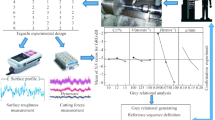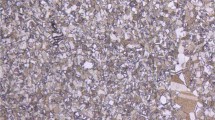Abstract
Grey cast iron (GCI) is the most common metal casting product in the world. Therefore, achieving sustainable production for this particular material will provide a significant impact on the sustainability issue of metal industries in general. This paper attempts to enhance the sustainability of grey cast iron turning through a high speed, dry turning process. The effect of cutting parameters on three assessments of product sustainability index (PSI) called energy consumption (EC), tool cost (TC), and surface roughness (SR) was investigated using the Taguchi method. The analysis of the signal to noise (S/N) ratio shows that the minimum depth of cut (0.1 mm) gives the optimal performance for all three assessments. Meanwhile, the cutting speed and feed rate reveal a conflict in obtaining the best performance. To help with making a decision, a Taguchi-based Bayesian optimization method was proposed and the capability of the method on suppressing the number of samples to obtain the optimum cutting parameters was demonstrated. Furthermore, the reasons for the optimum cutting condition were also presented.
















Similar content being viewed by others
Abbreviations
- GCI:
-
Grey cast iron
- S/N:
-
Signal to noise ratio
- CBN:
-
Cubic boron nitride
- BUL:
-
Built-up layer
- PSI:
-
Product sustainability index
- EE:
-
Environmental effect
- OH:
-
Operator health
- WC:
-
Workpiece cleaning
- CRD:
-
Coolant recycling and disposal
- CC:
-
Coolant cost
- PE:
-
Processing efficiency
- TC:
-
Tool cost
- EC:
-
Energy consumption
- SR:
-
Surface roughness
- JIS:
-
Japanese industrial standards
- CNC:
-
Computer numerical control
- ANOVA:
-
Analysis of variance
- MSD:
-
Mean square deviation
- MRR:
-
Material removal rate
- SEM:
-
Scanning electron microscope
- EDX:
-
Energy dispersive X-ray spectroscopy
- FEM:
-
Finite element method
References
Lee, H., Song, J., Min, S., Lee, H., Song, K. Y., Chu, C. N., et al. (2019). Research trends in sustainable manufacturing: A review and future perspective based on research databases. International Journal of Precision Engineering and Manufacturing-Green Technology, 6(4), 809–819.
Jayal, A. D., Badurdeen, F., Dillon, O. W., Jr., & Jawahir, I. S. (2010). Sustainable manufacturing: Modeling and optimization challenges at the product, process and system levels. CIRP Journal of Manufacturing Science and Technology, 2(3), 144–152.
Ghosh, S., & Rao, P. V. (2015). Application of sustainable techniques in metal cutting for enhanced machinability: A review. Journal of Cleaner Production, 100, 17–34.
Kim, D., Kim, T. J. Y., Wang, X., Kim, M., Quan, Y., Oh, J. W., et al. (2018). Smart machining process using machine learning: A review and perspective on machining industry. International Journal of Precision Engineering and Manufacturing-Green Technology, 5(4), 555–568.
Abdalla, H. S., Baines, W., McIntyre, G., & Slade, C. (2007). Development of novel sustainable neat-oil metal working fluids for stainless steel and titanium alloy machining. Part 1. Formulation development. The International Journal of Advanced Manufacturing Technology, 34, 21–33.
Hegab, H. A., Darras, B., & Kishawy, H. A. (2018). Towards sustainability assessment of machining processes. Journal of Cleaner Production, 170(1), 694–703.
Goindi, G. S., & Sarkar, P. (2017). Dry machining: A step towards sustainable machining—Challenges and future directions. Journal of Cleaner Production, 165, 1557–1571.
Krolczyk, G. M., Maruda, R. W., Krolczyk, J. B., Wojciechowski, S., Mia, M., Nieslony, P., & Budzik, G. (2019). Ecological trends in machining as a key factor in sustainable production—A review. Journal of Cleaner Production, 218, 601–615.
Modern Casting—A publication of the American Foundry Society. (2019). Census of World Casting Production. https://www.moderncasting.com/index.php/issues/2019/12. Accessed 6 Feb 2020.
Pereira, A. A., Boehs, L., & Guesser, W. L. (2006). Dry machining: The influence of sulfur on the machinability of gray cast iron FC25. Journal of Materials Processing Technology, 179, 165–171.
Sarma, D. K., & Dixit, U. S. (2007). A comparison of dry and air-cooled turning of grey cast iron with mixed oxide ceramic tool. Journal of Materials Processing Technology, 190, 160–172.
Tu, G., Wu, S., Liu, J., Long, Y., & Wang, B. (2016). Cutting performance and wear mechanisms of Sialon ceramic cutting tools at high speed dry turning of gray cast iron. International Journal of Refractory Metals and Hard Materials, 54, 330–334.
Gastel, M., Konetschny, C., Reuter, U., Fasel, C., Schulz, H., Riedel, R., & Ortner, H. M. (2000). Investigation of the wear mechanism of cubic boron nitride tools used for the machining of compacted graphite iron and grey cast iron. International Journal of Refractory Metals and Hard Materials, 18, 287–296.
Heck, M., Ortner, H. M., Flege, S., Reuter, U., & Ensinger, W. (2008). Analytical investigations concerning the wear behaviour of cutting tools used for the machining of compacted graphite iron and grey cast iron. International Journal of Refractory Metals and Hard Materials, 26, 197–206.
Fiorini, P., & Byrne, G. (2016). The influence of built-up layer formation on cutting performance of GG25 grey cast iron. CIRP Annals-Manufacturing Technology, 65, 93–96.
Liang, X., Liu, Z., Liu, W., & Li, X. (2019). Sustainability assessment of dry turning Ti-6Al-4V employing uncoated cemented carbide tools as clean manufacturing process. Journal of Cleaner Production, 214, 279–289.
Shin, S. J., Suh, S. H., Stroud, I., & Yoon, S. C. (2017). Process-oriented life cycle assessment framework for environmentally conscious manufacturing. Journal of Intelligent Manufacturing, 28, 1481–1499.
Sihag, N., & Sangwan, K. S. (2020). A systematic literature review on machine tool energy consumption. Journal of Cleaner Production, 275, 123125.
Peng, T., & Xu, X. (2014). Energy-efficient machining systems: A critical review. The International Journal of Advanced Manufacturing Technology, 72, 1389–1406.
Mert, G., Waltemode, S., & Aurich, J. C. (2015). How services influence the energy efficiency of machine tools: A case study of a machine tool manufacturer. Procedia CIRP, 29, 287–292.
Zhao, G. Y., Liu, Z. Y., He, Y., Cao, H. J., & Guo, Y. B. (2017). Energy consumption in machining: Classification, prediction, and reduction strategy. Energy, 133, 142–157.
Behrendt, T., Zein, A., & Min, S. (2012). Development of an energy consumption monitoring procedure for machine tools. CIRP Annals, 61(1), 43–46.
Shin, S. J., Woo, J., Rachuri, S., & Seo, W. (2019). An energy-efficient process planning system using machine-monitoring data: A data analytics approach. Computer-Aided Design, 110, 92–109.
Salonitis, K., & Ball, P. (2013). Energy efficient manufacturing from machine tools to manufacturing systems. Procedia CIRP, 7, 634–639.
Aramcharoen, A., & Mativenga, P. T. (2014). Critical factors in energy demand modelling for CNC milling and impact of toolpath strategy. Journal of Cleaner Production, 78, 63–74.
Shin, S. J., Woo, J., & Rachuri, S. (2017). Energy efficiency of milling machining: Component modeling and online optimization of cutting parameters. Journal of Cleaner Production, 161, 12–29.
Rao, R. V. (2011). Modeling and optimization of machining processes. In V. R. Rao (Ed.), Advanced modeling and optimization of manufacturing processes (pp. 55–175). Springer London.
Hu, L., Cai, W., Shu, L., Xu, K., Zheng, H., & Jia, S. (2020). Energy optimization for end face turning with variable material removal rate considering the spindle speed changes. International Journal of Precision Engineering and Manufacturing-Green Technology. https://doi.org/10.1007/s40684-020-00210-w
Liu, N., Zhang, Y. F., & Lu, W. F. (2019). Improving energy efficiency in discrete parts manufacturing system using an ultra-flexible job shop scheduling algorithm. International Journal of Precision Engineering and Manufacturing-Green Technology, 6(2), 349–365.
Camposeco-Negrete, C. (2013). Optimization of cutting parameters for minimizing energy consumption in turning of AISI 6061 T6 using Taguchi methodology and ANOVA. Journal of Cleaner Production, 53, 195–203.
Camposeco-Negrete, C. (2015). Optimization of cutting parameters using response surface method for minimizing energy consumption and maximizing cutting quality in turning of AISI 6061 T6 aluminum. Journal of Cleaner Production, 91, 109–117.
Deng, Z., Lv, L., Huang, W., & Shi, Y. (2019). A high efficiency and low carbon oriented machining process route optimization model and its application. International Journal of Precision Engineering and Manufacturing-Green Technology, 6(1), 23–41.
Perdomo, I. L. F., Quiza, R., Haeseldonckx, D., & Rivas, M. (2019). Sustainability-focused multi-objective optimization of a turning process. International Journal of Precision Engineering and Manufacturing-Green Technology. https://doi.org/10.1007/s40684-019-00122-4
Muhammad, I., Khatoon, T., Ullah, S. M. S., & Ko, T. J. (2018). Development of empirical model for biomachining to improve machinability and surface roughness of polycrystalline copper. International Journal of Precision Engineering and Manufacturing-Green Technology, 5, 201–209.
Montgomery, D. C. (2013). Design and analysis of experiments (8th ed.). Wiley.
Roy, R. (2010). A primer on the Taguchi method (2nd ed.). Society of Manufacturing Engineers.
Parida, A. K., & Maity, K. (2019). Modeling of machining parameters affecting flank wear and surface roughness in hot turning of monel-400 using response surface methodology (RSM). Measurement, 137, 375–381.
Herwan, J., Kano, S., Oleg, R., Sawada, H., Kasashima, N., & Misaka, T. (2020). Predicting surface roughness of dry cut grey cast iron based on cutting parameters and vibration signals from different sensor positions in CNC turning. International Journal of Automation Technology, 14, 217–228.
Bhinge, R., Park, J., Law, K. H., Dornfeld, D. A., Helu, M., & Rachuri, S. (2017). Toward a generalized energy prediction model for machine tools. Journal of Manufacturing Science and Engineering, 139, 041013.
Liu, M., Cheung, C., Feng, X., Ho, L., & Yang, S. (2019). Gaussian process machine learning- based surface extrapolation method for improvement of the edge effect in surface filtering. Measurement, 137, 214–224.
Misaka, T., Herwan, J., Kano, S., Oleg, R., Sawada, H., Kasashima, N., & Furukawa, Y. (2020). Prediction of surface roughness in CNC turning by model-assisted response surface method. Precision Engineering, 62, 196–203.
Jones, D. R., Schonlau, M., & Welch, W. J. (1998). Efficient global optimization of expensive black box functions. Journal of Global Optimization, 13, 455–492.
Forrester, A. I. J., Sóbester, A., & Keane, A. J. (2007). Multi-fidelity optimization via surrogate modelling. Proceedings of the Royal Society A, 463, 3251–3269.
Forrester, A. I. J., Sóbester, A., & Keane, A. J. (2008). Engineering design via surrogate modelling: A practical guide. Wiley.
Voigt, R. C., Marwanga, P. H., & Cohen, P. H. (1999). Machinability of gray iron—mechanics of chip formation. International Journal of Cast Metals Research, 11, 567–572.
Bilga, P. S., Singh, S., & Kumar, R. (2016). Optimization of energy consumption response parameters for turning operation using Taguchi method. Journal of Cleaner Production, 137, 1406–1417.
Yang, W. H., & Tarng, Y. S. (1998). Design optimization of cutting parameters for turning operations based on the Taguchi method. Journal of Materials Processing Technology, 84, 122–129.
Maier, M., Zwicker, R., Akbari, M., Rupenyan, A., & Wegener, K. (2019). Bayesian optimization for autonomous process set-up in turning. CIRP Journal of Manufacturing Science and Technology, 26, 81–87.
Nguyen, D., Tooptong, S., Park, K. H., & Kwon, P. (2020). Formation mechanism of alumina layer in protecting cubic boron nitride inserts in turning cast irons. International Journal of Machine Tools & Manufacture, 153, 103539.
Abukhshim, N. A., Mativenga, P. T., & Sheikh, M. A. (2006). Heat generation and temperature prediction in metal cutting: A review and implications for high speed machining. International Journal of Machine Tools & Manufacture, 46, 782–800.
Tu, L., & Shi, W. (2020). Establish using FEM method of constitutive model for chip formation in the cutting process of gray cast iron. Metals, 10, 33.
Angseryd, J., Coronel, E., Elfwing, M., Olsson, E., & Andrén, H. O. (2009). The microstructure of the affected zone of a worn PCBN cutting tool characterised with SEM and TEM. Wear, 267, 1031–1040.
Acknowledgements
The authors would like to thank the Ministry of Economy, Trade, and Industry (METI) of Japan for providing the funds through the project entitled “Study on smart manufacturing system design and technology”. The authors would also like to acknowledge Dr. Naoko Sato and Dr. M. Shahien (AIST) for the support and guidance on using the SEM-EDX apparatus.
Author information
Authors and Affiliations
Corresponding author
Ethics declarations
Conflict of interest
On behalf of all authors, the corresponding author states that there is no conflict of interest.
Additional information
Publisher's Note
Springer Nature remains neutral with regard to jurisdictional claims in published maps and institutional affiliations.
Appendix: Bayesian Optimization Procedure
Appendix: Bayesian Optimization Procedure
The prediction \(\widehat{y}\left({\varvec{x}}\right)\), which corresponds to the cost function for a vector variable \({\varvec{x}}={\left[{x}_{1},{x}_{2},\ldots ,{x}_{m}\right]}^{T}\) composed of operation conditions in turning is given as follows:
where \({\varvec{y}}={\left[{y}_{1},{y}_{2},\ldots ,{y}_{n}\right]}^{T}\) corresponds to a vector of the cost function that corresponds to \(n\) different experiments, and 1 represents a unit vector. The subscript \(m\) indicates the number of operational parameters considered for constructing the model. The covariance matrix is defined as:
where the correlation function is defined as follows:
The vector \({\varvec{\psi}}\) in Eq. (10) is the correlation of the sampled parameter sets and a parameter set \({\varvec{x}}\) to be predicted as follows:
The average component \(\mu\) in Eq. (10) is defined as \(\mu ={(1}^{T}{\Psi }^{-1}{\varvec{y}})/({1}^{T}{\Psi }^{-1}1)\) and the variance \({\sigma }^{2}\) is defined as follows:
The hyperparameter \({\varvec{\theta}}={\left[{\theta }_{1},{\theta }_{2},\ldots ,{\theta }_{m}\right]}^{T}\) used in Eq. (12) is obtained by maximizing a ln-likelihood function given as:
The maximization of the ln-likelihood function is performed using a genetic algorithm to find the hyperparameter \({\varvec{\theta}}\) that best represents the sampled data sets.
Once the surrogate model of a cost function is constructed based on the above procedures, it is possible to minimize/maximize a function value as well as to evaluate indices for improving the surrogate model itself. Both purposes can be achieved simultaneously using expected improvement realizing so-called Bayesian optimization. The expected improvement can be calculated by:
where \(\mathrm{erf}\) indicates an error function,\({y}_{\mathrm{min}}\) is the current minimum while \(\widehat{s}\) is standard deviation obtained from the constructed surrogate model, which is obtained by:
All the quantities used in Eqs. (16) and (17) are obtained during the construction of the surrogate model. In the Bayesian optimization, \(EI\left({\varvec{x}}\right)\) is used to locate an additional sample point, i.e., a candidate of experimental conditions. The candidate of parameters \({\varvec{x}}\) is searched also by a genetic algorithm using \(EI\left({\varvec{x}}\right)\) as a cost function.
Constraints associated with monitored quantities such as surface roughness can be considered in the Bayesian optimization procedure by considering \(EI\left({\varvec{x}}\right)PF({\varvec{x}})\) with \(PF\left({\varvec{x}}\right)\) represented by:
where \(g\) is the constraint function, \({g}_{\mathrm{min}}\) is the constraint value, \(G\left(x\right)\) is a random variable. In the present case, surface roughness \(Ra\) is considered as a constraint.
Rights and permissions
Springer Nature or its licensor holds exclusive rights to this article under a publishing agreement with the author(s) or other rightsholder(s); author self-archiving of the accepted manuscript version of this article is solely governed by the terms of such publishing agreement and applicable law.
About this article
Cite this article
Herwan, J., Misaka, T., Kano, S. et al. Improving Sustainability Index of Grey Cast Iron Finish Cutting Through High-Speed Dry Turning and Cutting Parameters Optimization Using Taguchi-Based Bayesian Method. Int. J. of Precis. Eng. and Manuf.-Green Tech. 10, 729–745 (2023). https://doi.org/10.1007/s40684-022-00457-5
Received:
Revised:
Accepted:
Published:
Issue Date:
DOI: https://doi.org/10.1007/s40684-022-00457-5




